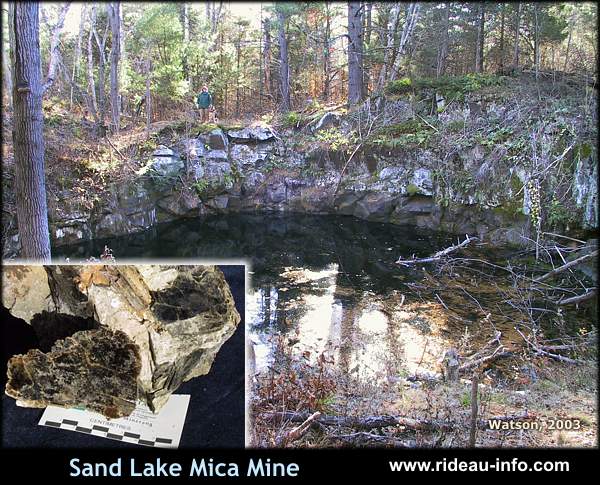 |
 |
| Sand Lake Mica Mine photo by: Ken Watson, 2003 |
|
The Rideau area has a rich history of small scale mining. The Sand Lake Mine is a good example. In the photo, we see what is left of the mine, a circular pit, some 25 feet across and reportedly 75 feet deep, now filled with water. The inset photo shows what they were mining; sheets of mica. It started off as a phosphate mine in about 1870 when Mr. Ed Schultze mined fifteen tons of apatite (for phosphate) for export to Germany. In 1900, it was acquired by the Brockville Mining Company who mined it that year for its mica content. It was known at the time as the McLaren and Fulford mine and sometimes as the Hardy Mine. It was mined again from 1905 to 1907. The dumps were worked in 1910 and the last known mining was done in 1912 by Mr. Mendels and Mr. Smith of Perth, when 12 tons of mica, with a value of $20,570 at the time, was mined. By 1916 it appears that the mine was owned by Mr. Fahey and Mr. Sullivan of Elgin, but it unclear if they did any further mining other than to scavenge the dumps. The mine is a chimney deposit of phlogopite mica, located in fissures that run through pyroxenite and biotite gneiss. The product was sheets of mica which were hand cobbed (sorted by hand) on site and then shipped south. Mica was used for windows, in stove and furnace doors, goggles and lamp chimneys. In the twentieth century uses for mica developed for insulation and electrical equipment. Ground mica is also used in the manufacture of paints, wallpaper and lubricants. Mica has many applications in the electrical industry due to its high dielectric strength, uniform dielectric constant/capacitance stability, low power loss and high electrical resistivity. The electrical properties of mica make it a unique mineral. The mining history of the Rideau area is quite varied. The mining of iron in the Lyndhurst area started around 1800. In 1801 Wallis Sunderlin, a Vermont founderer, established the first iron works in Upper Canada (Ontario) at Furnace Falls (now Lyndhurst). It operated until 1811 when it was destroyed by fire. Most of the iron ore was hematite, mined from properties about 1.5 km south of Delta. The last mining in the area appears to have been done in 1918-19. Some galena (for lead) was also mined in the Lyndhurst area in the period between about 1854 and 1880. Hematite (iron) has been mined in small quantities in various locations in the region. For instance, in 1899, about 600 tons of iron ore was mined and shipped from the Dog Lake Hematite Mine. In some places Ochre is associated with Hematite and in the early 1900s, a pocket of ochre in marble was mined for pigment purposes at a location between Morton and Jones Falls. Near Newboro, the Matthews Mine and the Chaffeys Mine produced a quantity of iron from titaniferous magnetite. The first shipment of 4,000 tons of ore was transported down the Rideau to Kingston in 1858. Both mines operated until about 1871. There have over twenty mica mines in the region, including the Sand Lake Mine, Opinicon Rock Lake Mine, Opinicon Lake Mine and the Stoness Mine. Tours are available today of the Silver Queen Mica Mine, located in Murphys Point Provincial Park (Big Rideau Lake). In North Burgess Township, north of Big Rideau Lake, the Timmins mine produced graphite from 1918 to 1923. More recently, the Portland Graphite Mine produced graphite in the mid-1990s. Of course we can't forget the many quarries that mined stone (usually sandstone, sometimes limestone) for the building of the Rideau Canal. Many of those quarries also supplied stone to various local homes and churches. More recently, in some areas, granite has been mined for monument blocks. |
| Press your BACK button to return to the originating page or ... |